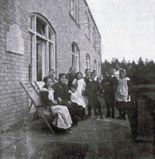Thomas Moffatt Allison was born in 1861 in Guisbrough, North Yorkshire, the son of a mining engineer. He went on to study medicine and appears to have moved to Newcastle in the 1890s and by 1901 is recorded in the census as living and working at Dene House Hospital, a private hospital in Ellison Place, Newcastle.
During this time he was heavily involved with the Poor Children’s Holiday Association (PCHA), the charity behind Stannington Sanatorium, holding the role of Honorary Physician to the PCHA and sitting on its General Management Committee. Through his position within the charity he was instrumental in the establishment of the sanatorium at Stannington, which is clear from the annual reports of PCHA. In the 1906 annual report Dr Allison explains what is currently being done to tackle tuberculosis in the area as well as detailing the benefits that a sanatorium at Stannington will bring:
“Speaking of consumption, we have had quite a number of examples of local tuberculosis (bone and gland cases), and also of lung tuberculosis (or consumption), during the year. These we have provided for as well as we could, – having regard to the danger of infecting others if sent to homes where there are other children – that is to say, we have isolated them as far as possible, and provided sputum flasks, etc.
But to cope properly with consumptive children there must be a proper place for them. And we are indeed glad that next Spring our Stannington Sanatorium – (the first in England) for Consumptive Children, will be ready for opening.” [HOSP/STAN/1/3/2]
![Patients and Staff Outside the Sanatorium c.1920s [HOSP/STAN/11/1/54]](http://www.northumberlandarchives.com/wp-content/uploads/2015/01/HOSP-STAN-11-01-54-300x192.jpg)
Once the sanatorium opened in 1907 his close involvement with institution continued as he took on the role of visiting physician and quite clearly held the sanatorium and its young patients close to his heart. The matron in July 1916 made the following comments about a visit he made:
“Dr Allison brought out with him a gentleman to look over the Institution – he also gave me £1 to buy something for the children & has promised to send us records for our gramophone.” [HOSP/STAN/2/1/1]
Various reports on the early days of the Sanatorium along with newspaper articles from the time show Dr Allison to have been a consistent presence in some of the day to day operations of the Sanatorium and not just the medical side of things. His presence at social events and in children’s Christmas parties is reported upon on several occasions.
During his career he wrote extensively on the treatment of tuberculosis and childhood disease with many articles and letters published in the British Medical Journal. He was also active in other areas of local society and was the President of Newcastle Rotary Club and also stood for parliament as a coalition candidate for Morpeth Borough, but was unsuccessful in this particular political venture.
He died in Newcastle on 9 October 1928 leaving a widow, Frances Sarah Allison. His son Gordon, a Lieutenant in the 1st King George’s Gurkha Rifles predeceased him having died in action in north-west India on 8th June 1919 aged 20.
Sources:
‘A Nation of Workers. Will a Nobler Understanding Arise from Comradeship?’, North-Eastern Daily Gazette, 4 Nov 1916
‘Northumberland. Vigorous Contests Anticipated.’ Yorkshire Post and Leeds Intelligencer, 20 Nov 1918


